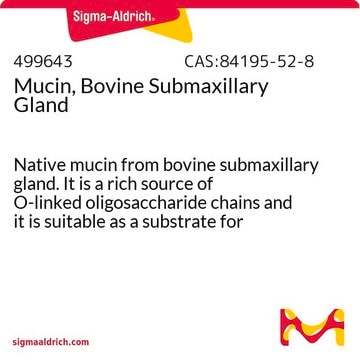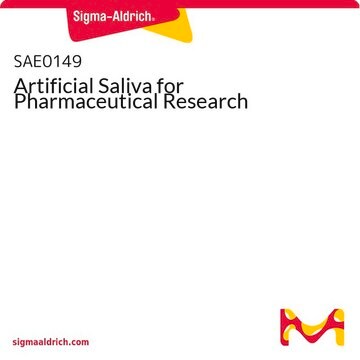Mucin from bovine submaxillary glands, item M3895, can be dissolved/reconstituted in H2O or dilute aqueous alkaline buffers.
M3895
Mucin from bovine submaxillary glands
Type I-S
Synonyme(s) :
MUC
About This Item
Produits recommandés
Source biologique
bovine submaxillary glands
Niveau de qualité
Type
Type I-S
Forme
powder
Composition
Bound sialic acids, 9-24%
Technique(s)
electrophoresis: suitable
Numéro d'accès UniProt
Température de stockage
−20°C
Informations sur le gène
cow ... BSM(286841)
Vous recherchez des produits similaires ? Visite Guide de comparaison des produits
Catégories apparentées
Description générale
Application
- in the quantification of mucin[3]
- as a component of artificial tear solution[4]
- as a substrate for recombinant sialidase Gardnerella vaginalis[5]
- to investigate a galactose-specific lectin from the red marine alga Ptilota filicina
- to study the characterization of a unique mucin-like glycoprotein secreted by a human endometrial adenocarcinoma cell line (Ishikawa)
Actions biochimiques/physiologiques
Liaison
Substrats
Code de la classe de stockage
11 - Combustible Solids
Classe de danger pour l'eau (WGK)
WGK 3
Point d'éclair (°F)
Not applicable
Point d'éclair (°C)
Not applicable
Équipement de protection individuelle
Eyeshields, Gloves, type N95 (US)
Faites votre choix parmi les versions les plus récentes :
Certificats d'analyse (COA)
Vous ne trouvez pas la bonne version ?
Si vous avez besoin d'une version particulière, vous pouvez rechercher un certificat spécifique par le numéro de lot.
Déjà en possession de ce produit ?
Retrouvez la documentation relative aux produits que vous avez récemment achetés dans la Bibliothèque de documents.
Les clients ont également consulté
Articles
Understand sialic acid structure, function, signaling, and modifications. Easily find products for sialic acid research.
Understand sialic acid structure, function, signaling, and modifications. Easily find products for sialic acid research.
Understand sialic acid structure, function, signaling, and modifications. Easily find products for sialic acid research.
Understand sialic acid structure, function, signaling, and modifications. Easily find products for sialic acid research.
-
What is the recommended method to dissolve Mucin from bovine submaxillary glands, item M3895?
1 answer-
Helpful?
-
Active Filters
Notre équipe de scientifiques dispose d'une expérience dans tous les secteurs de la recherche, notamment en sciences de la vie, science des matériaux, synthèse chimique, chromatographie, analyse et dans de nombreux autres domaines..
Contacter notre Service technique













